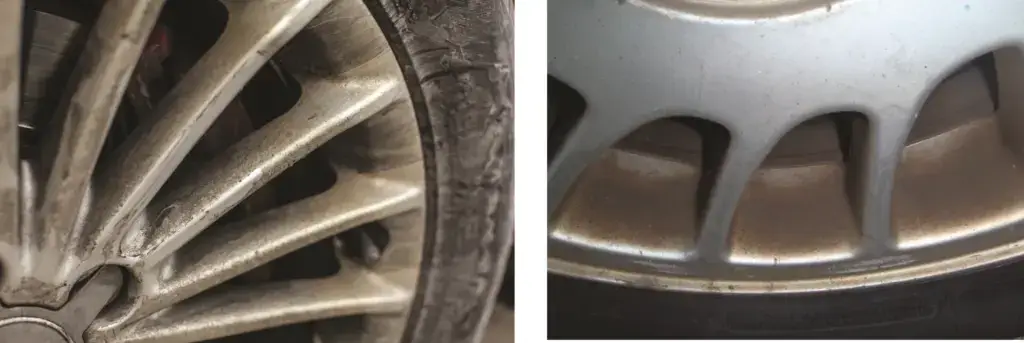What causes brake dust?
Brake dust is just residual friction material and rotor particles.
All brakes create brake dust. A light dusting is normal. But excessive dust on your wheels is often the sign of serious brake issues. If you have excessive dust, get your brakes inspected.
What’s in brake pad friction material?
Depending on the type of friction material; non-asbestos organic (NAO), semi-metallic, or ceramic, brake pads contain a combination of these raw materials:
- zirconium silicate and aluminum oxide as abrasives
- friction particles derived from cashew shells
- steel wool
- wire
- copper (new EPA rules require the reduction/elimination of copper in brake pads)
- Whiting (Chalk)
- Bronze powder
- Graphite (as a lubricant)
- Vermiculite
- Rubber particles
- Friction Dust
- Sand
- Fillers like calcium carbonate, barytes, and wollastonite
- chopped fiberglass strand
- aluminum oxide
Why the dust on wheels is so hard to remove
If it’s just dust, why doesn’t it just wipe off? Because brake dust etches itself into the clear coat and then the metal on your wheels. It’s a long story and you can read how it happens HERE. But the bottom line is that the more dust you create and the longer you leave it on your wheels, the harder it is to remove.
The type of brake pad and the brake pad formula determines the amount of dust on your wheels
There are two types of brake pad friction materials; abrasive and adherent. NAO and ceramic pads fall into the adherent category, while semi-metallic pads fall into the abrasive category. In truth, brake pads are never 100% adherent or abrasive; they’re a combination of both.
For an in-depth discussion on adherent versus abrasive brake pads, see this post
How adherent brake pads work
During the bedding process adherent brake pads heat up and deposit a “transfer layer” of pad material onto the surface of the brake rotor. Once the transfer layer is laid down, braking is accomplished by rubbing the pad against the transfer layer. The high heat from friction destroys the transfer layer and causes the pad to lay down more transfer film onto the rotor.
Adherent brake pads are softer than the rotor. So pads wear more than the rotor. They also produce far less brake dust on your wheels; although the exact amount of brake dust depends on the pad’s formula
How abrasive brake pads work
As the name implies, abrasive brake pads work by creating friction through abrasion. Abrasive brake pads are more likely to contain higher levels of zirconium silicate and aluminum oxide (the materials you find in sandpaper), steel wool fibers, bronze, and sand. As a result, abrasive brake pads wear out the rotor much faster than the pad and create far more brake dust.
Harder braking = more dust
The amount of dust you create depends not only on the type of brake materials used, but also their coefficient of friction and how hard you brake. One thing is clear from environmental testing; the harder you brake, the more brake dust you create.
Is brake dust harmful?
You bet. Studies show that the small bits shed from the brake pads contained heavy metals like mercury, lead and cadmium. Heavy metals can cause cancer and birth defects. The U.S. EPA is working to reduce heavy metals in brake friction material, and thus in brake dust.
©, 2023 Rick Muscoplat
Posted on by Rick Muscoplat
